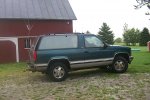So I'm taking my technician exam tomorrow and I'm pretty confident that I'm going to pass. Of course if I do this means that I'm going to need a radio and I have been looking at my options. I think I plan on upgrading to general once I learn the ropes since this would really open up some interesting options. I may even be able to talk with some of you more southern ExPo members.:victory:
My question is should I spend the big bucks now and get a transceiver with HF capabilities or stick to at least a dual bander?
The radios I am looking at are Yaesu FT-857D and the FT8900R. The 857 sounds like a really powerfull little mobile but the price is about twice that of the other one. It also has a cool Defender in it's brocure that makes it look even more appealing to me. :drool:
http://www.yaesu.com/downloadFile.cfm?FileID=787&FileCatID=156&FileName=FT%2D857%5FBrochure.pdf&FileContentType=application%2Fpdf
My question is should I spend the big bucks now and get a transceiver with HF capabilities or stick to at least a dual bander?
The radios I am looking at are Yaesu FT-857D and the FT8900R. The 857 sounds like a really powerfull little mobile but the price is about twice that of the other one. It also has a cool Defender in it's brocure that makes it look even more appealing to me. :drool:
http://www.yaesu.com/downloadFile.cfm?FileID=787&FileCatID=156&FileName=FT%2D857%5FBrochure.pdf&FileContentType=application%2Fpdf


